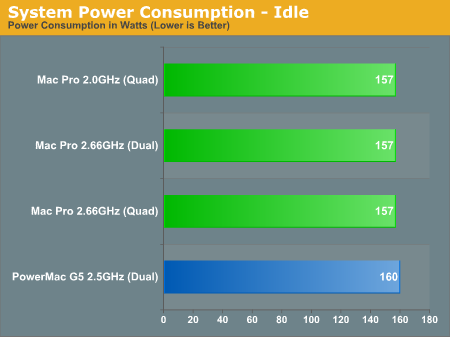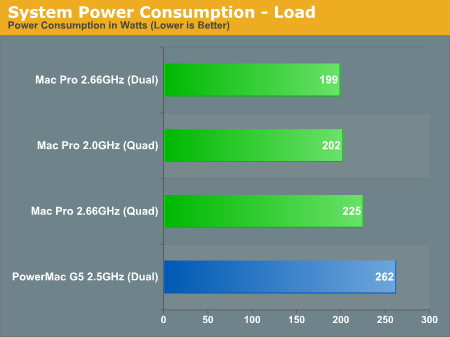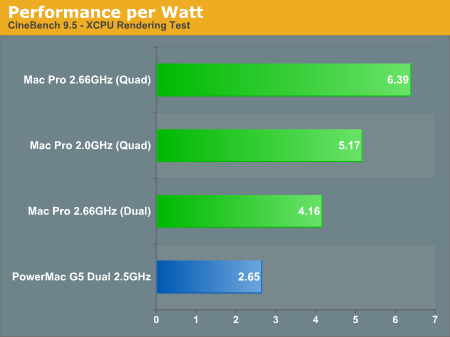Apple's Mac Pro - A True PowerMac Successor
by Anand Lal Shimpi on August 16, 2006 12:27 PM EST- Posted in
- Mac
Power Consumption
According to Apple, the biggest reason for its switch to Intel processors was the chipmaker's future roadmap and its promise for lower power consumption and better performance per watt.
We've already seen how much smaller the Xeon heatsinks are in the Mac Pro compared to the older G5 units, and we've talked about how much quieter the Mac Pro is than its predecessor, but what about power consumption at the wall?

At idle, the Mac Pro with four cores uses no more power than the dual processor PowerMac G5. Of course at idle, each core's cache is being powered down, the CPU is being underclocked, and all of Intel's famed power management is hard at work.

Under load, running the multithreaded CineBench test, the Mac Pro consumes significantly less power than the PowerMac G5 even when running with all four cores enabled.
And just to save you from doing the math, here's a graph of performance per watt when running the same CineBench test:

At 65nm, the Xeons in the Mac Pro are obviously more efficient than the 90nm PowerPC G5, but the performance per watt these new parts offer is tremendous.










96 Comments
View All Comments
tmohajir - Thursday, August 17, 2006 - link
I had the same question. I was debating whether to by 2 x 512MB or 1GB, and then thought it might affect performance if I went with the 1GB sticks. I think for now the best bet would be to buy 2 512s so that each branch has a channel with the same amount of memory. Then if I want to upgrade later, move all 4 512s to riser 1, and buy 2 1GB dimms when the price drops a little more and stick them in riser 2. So that way you still have 2GB total per branch.dborod - Thursday, August 17, 2006 - link
I decided to order my MacPro with 4 x 512 MB dimms so as to be able to fully utilize the available memory bandwidth. It seemed the easiest and safest approach for now.dborod - Thursday, August 17, 2006 - link
I decided to order my MacPro with 4 x 512 MB dimms so as to be able to fully utilize the available memory bandwidth. It seemed the easiest and saQuestar - Wednesday, August 16, 2006 - link
Why use MP3 encoding for performace testing in a multi cpu environment? MP3 encoding is not very threadable, and most likely is not threaded to any great extent in iTunes.Griswold - Thursday, August 17, 2006 - link
Somebody obviously has never used the multithreaded encoder of the LAME MT project. I see gains of up to 50% with that. Sure, that may not be relevant for a mac pro user, but it is proof that MP3 encoding benefits from SMT.Questar - Thursday, August 17, 2006 - link
Griswald stikes again.Yes I've heard of LAMEMT. So how's that sound quality you're getting without a bit resevoir? Pretty crappy I'll bet.
Griswold - Friday, August 18, 2006 - link
Oh give me a break nutsack. Dont pretend you know what you're talking about here, as it doesnt match your first (false) post - you obviously never used LameMT. Disabling bit reservoir may come with a certain loss of quality, but its not nearly as much as you (or the poster above) want it to make to be. I'm willing to bet 95% of the people using mp3 wont notice the difference.I'm listening to the same song encoded with standard Lame and LameMT and the quality is virtually the same. Of course, you'll now say your ears are so much better, you got so much better audio equipment and what not.. but meh, it's just questdork talking.
michael2k - Saturday, August 19, 2006 - link
The same 95% of the population who purchase tracks from the iTMS I bet :)Questar - Friday, August 18, 2006 - link
Thanks for the best laugh I've had all week!I really needed it!!
saratoga - Thursday, August 17, 2006 - link
Yeah but you also lose quality, so very few people use it.
Not exactly. LAMEMT is only multithreaded when you use parts of the MP3 standard that can be multithreaded. Typical MP3 encoding as done by lame, itunes, xing, etc simply can not be multithreaded. LAMEMT can be multithreaded because it disables certain features that are incompatable and then implements software pipelining.
The LAME devs have talked about trying to work around this problem in the past, but so far most people seem to think its just not worth the effort because the speed up is much worse then just running two copies of LAME (which gives a 100% speedup verses the 50% you saw), and of course the unresolved questions about just how badly quality would be hurt by rewriting LAME profiles from scratch to use the approach in LAMEMT.